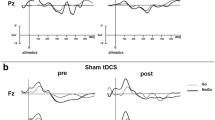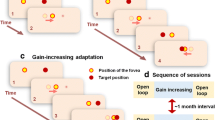Abstract
Ample evidence exists that the cerebellum is involved in associative motor learning, particularly in eyeblink-conditioning. In visuomotor associative learning the role of the cerebellum is less clear. One open question is whether cerebellar patients’ deficits in visuomotor learning are present both in a stimulus-response and a stimulus-stimulus-response association task. Twelve patients with cerebellar degeneration and 12 healthy matched control subjects participated. A magnetic resonance imaging (MRI) volumetric analysis of the cerebellum was performed to assess the degree of cerebellar atrophy. In a blocked design, subjects had to learn the association between one color square or two color squares and a right or left key press. In the latter condition, the two colors were shown one after the other in the same sequence except for two blocks at the end of the experiment. Overall, cerebellar subjects reacted significantly slower than controls. In both groups, reaction time decreased over blocks, and the learning effect was more pronounced in the stimulus-response than in the stimulus-stimulus-response condition. Post hoc analyses revealed that learning differences between conditions were significant in cerebellar patients but not control subjects. Furthermore, only healthy subjects were irritated, i.e., they significantly increased reaction times in the blocks with reversed sequence in the stimulus-stimulus-response condition. Cerebellar subjects tended to name less correct stimulus-stimulus-response associations after the experiment. Finally, cerebellar volume correlated with parameters of motor performance, but not learning. In conclusion, cerebellar patients showed deficits in stimulus-stimulus-response, but not stimulus-response learning. Future experiments are needed to differentiate between possible deficits in learning the stimulus-stimulus association, use of sequence information, and/or impaired motor performance interfering with learning.



Similar content being viewed by others
References
Akshoomoff NA, Courchesne E, Press GA, Iragui V (1992) Contribution of the cerebellum to neuropsychological functioning: evidence from a case of cerebellar degenerative disorder. Neuropsychologia 30:315–328
Ashburner J, Friston KJ (2000) Voxel-based morphometry: the methods. Neuroimage 11:805–821
Beck AT (1993) Beck depressions inventar. Huber, Berlin
Bischoff-Grethe A, Ivry RB, Grafton ST (2002) Cerebellar involvement in response reassignment rather than attention. J Neurosci 22:546–553
Bracha V, Zhao L, Irwin KB, Bloedel JR (2000) The human cerebellum and associative learning: dissociation between the acquisition, retention and extinction of conditioned eyeblinks. Brain Res 860:87–94
Bracke-Tolkmitt R, Linden A, Canavan AGM, Rockstroh B, Scholz E, Wessel K, Diener HC (1989) The cerebellum contributes to mental skills. Behav Neurosci 103:442–446
Canavan AG, Sprengelmeyer R, Diener HC, Homberg V (1994) Conditional associative learning is impaired in cerebellar disease in humans. Behav Neurosci 108:1–11
Courtney SM, Ungerleider LG, Keil K, Haxby JV (1996) Object and spatial visual working memory activate separate neural systems in human cortex. Cereb Cortex 6:39–49
Daum I, Ackermann H (1995) Cerebellar contributions to cognition. Behav Brain Res 67:201–210
Daum I, Ackermann H (1997) Nondeclarative memory: neuropsychological findings and neuroanatomic principles. Fortschr Neurol Psychiatr 65:122–132
Daum I, Ackermann H, Schugens MM, Reimold C, Dichgans J, Birbaumer N (1993) The cerebellum and cognitive functions in humans. Behav Neurosci 107:411–419
Desmond JE, Gabrieli JD, Wagner AD, Ginier BL, Glover GH (1999) Lobular patterns of cerebellar activation in verbal working-memory and finger-tapping tasks as revealed by functional MRI. J Neurosci 17:9675–9685
Drepper J, Timmann D, Kolb FP, Diener HC (1999) Non-motor associative learning in patients with degenerative cerebellar disease. Brain 122:87–97
Frings M, Boenisch R, Gerwig M, Diener HC, Timmann D (2004) Learning of sensory sequences in cerebellar patients. Learn Mem 11:347–355
Gerwig M, Dimitrova A, Kolb FP, Maschke M, Brol B, Kunnel A, Böring D, Thilmann AF, Forsting M, Diener HC, Timmann D (2003) Comparison of eyeblink conditioning in patients with superior and posterior inferior cerebellar lesions. Brain 126:71–94
Hartje W, Rixecker H (1978) Der Recurring-Figures-Test von Kimura. Normierung an einer deutschen Stichprobe. Nervenarzt 49:354–356
Ishihara S (1990) Ishihara’s design charts for color-blindness of unlettered persons. Kanehara, Tokyo
Kimura D (1963) Right temporal lobe damage. Arch Neurol 8:264–271
Lang CE, Bastian AJ (2002) Cerebellar damage impairs automaticity of a recently practiced movement. J Neurophysiol 87:1336–1347
Maschke M, Drepper J, Buergerhoff K, Calabrese S, Kolb FP, Daum I, Diener HC, Timmann D (2002) Differences in trace and delay visuomotor associative learning in cerebellar patients. Exp Brain Res 147:538–548
Middleton FA, Strick PL (2001) Cerebellar projections to the prefrontal cortex of the primate. J Neurosci 21:700–712
Molinari M, Leggio MG, Solida A, Ciorra R, Misciagna S, Silveri MC, Petrosini L (1997) Cerebellum and procedural learning: evidence from focal cerebellar lesions. Brain 120:1753–1762
Nixon PD, Passingham RE (1999) The cerebellum and cognition: cerebellar lesions do not impair spatial working memory or visual associative learning in monkeys. Eur J Neurosci 11:4070–4080
Nixon PD, Passingham RE (2000) The cerebellum and cognition: cerebellar lesions impair sequence learning but not conditional visuomotor learning in monkeys. Neuropsychologia 38:1954–1972
Posner MI, Petersen SE (1990) The attention system of the human brain. Annu Rev Neurosci 13:25–42
Raven JC (1956) Standard progressive matrices. Lewis, London
Schellig D, Hättig HA (1993) Die Bestimmung der visuellen Merkspanne mit dem Block-Board. Z Neuropsychol 2:104–112
Schmahmann JD (1997) The cerebellum and cognition. Academic, San Diego
Seidler RD, Purushotham A, Kim SG, Ugurbil K, Willingham D, Ashe J (2002) Cerebellum activation associated with performance change but not motor learning. Science 296:2043–2046
Shimansky Y, Timmann D, Kolb FP, Diener HC, Bloedel JR (1998) Acquisition of temporal patterns of auditory and visual cues is impaired in cerebellar patients. Soc Neurosci Abstr 24:1407
Silveri MC, Di Betta AM, Filippini V, Leggio MG, Molinari M (1998) Verbal short-term store-rehearsal system and the cerebellum. Evidence from a patient with a right cerebellar lesion. Brain 121:2175–2187
Thach WT (1998) What is the role of the cerebellum in motor learning and cognition? Trends Cogn Sci 2:331–337
Thompson RF, Kim JJ (1996) Memory systems in the brain and localization of a memory. Proc Natl Acad Sci U S A 93:13438–13444
Thompson RF, Bao S, Chen L, Cipriano BD, Grethe JS, Kim JJ, Thompson JK, Tracy JA, Weninger MS, Krupa DJ (1997) Associative learning. Int Rev Neurobiol 41:151–189
Timmann D, Drepper J, Maschke M, Kolb FP, Böring D, Thilmann AF, Diener HC (2002) Motor deficits cannot explain impaired cognitive associative learning in cerebellar patients. Neuropsychologia 40:788–800
Timmann D, Drepper J, Calabrese S, Bürgerhoff K, Maschke M, Kolb FP, Daum I, Diener HC (2004) Sequence information improves associative learning in control subjects but not cerebellar patients. Cerebellum 3:75–82
Trouillas P, Takayanagi T, Hallett M, Currier RD, Subramony SH, Wessel K, Bryer A, Diener HC, Massaquoi S, Gomez CM, Coutinho P, Ben Hamida M, Campanella G, Filla A, Schut L, Timmann D, Honnorat J, Nighoghossian N, Manyam B (1997) International cooperative rating scale for pharmacological assessment of the cerebellar syndrome. The Ataxia Neuropharmacology Committee of the World Federation of Neurology. J Neurol Sci 145:205–211
Tucker J, Harding AE, Jahanshahi M, Nixon PD, Rushworth M, Quinn NP, Thompson PD, Passingham RE (1996) Associative learning in patients with cerebellar ataxia. Behav Neurosci 110:1229–1234
Wechsler D (1987) Wechsler memory scale: revised. Psychological Corporation, New York
Winkler G, Hahn K, Aurich V, Martin A, Rodenacker K (1999) Noise reduction in images: some recent edge-preserving methods. Pattern Recognition Image Analysis 9:749–766
Wise SP, Murray EA (2000) Arbitrary associations between antecedents and actions. Trends Neurosci 23:271–276
Wise SP, Murray EA, Gerfen CR (1996) The frontal cortex-basal ganglia system in primates. Crit Rev Neurobiol 10:317–356
Woodruff-Pak DS, Vogel RW, Ewers M, Boyko OB, Lemieux SK (2001) MRI-assessed volume of cerebellum correlates with associative learning. Neurobiol Learn Mem 76:342–357
Yeo CH, Hesslow G (1998) Cerebellum and conditioned reflexes. Trends Cogn Sci 2:322–330
Zimmermann P, Fimm B (1992) Testbatterie zur Aufmerksamkeitsprüfung. Universität Freiburg
Acknowledgements
We would like to thank each cerebellar patient and control subject for their time and effort, and J. Drepper for developing the experimental setup. The study was supported by a grant of the Deutsche Forschungsgemeinschaft (DFG Ti 239/7–1).
Author information
Authors and Affiliations
Corresponding author
Rights and permissions
About this article
Cite this article
Richter, S., Matthies, K., Ohde, T. et al. Stimulus-response versus stimulus-stimulus-response learning in cerebellar patients. Exp Brain Res 158, 438–449 (2004). https://doi.org/10.1007/s00221-004-1920-3
Received:
Accepted:
Published:
Issue Date:
DOI: https://doi.org/10.1007/s00221-004-1920-3




